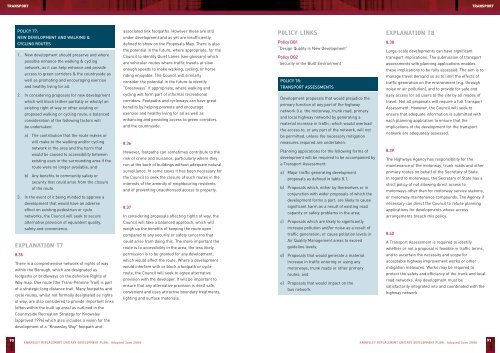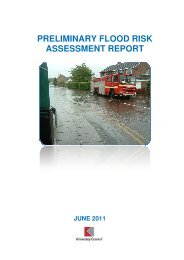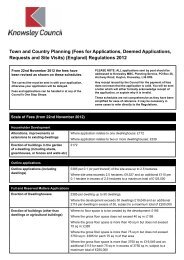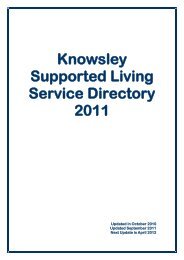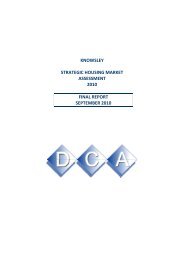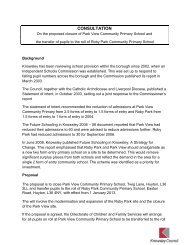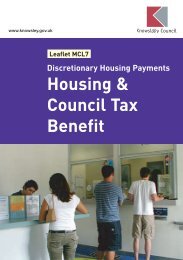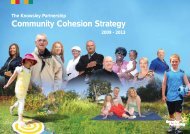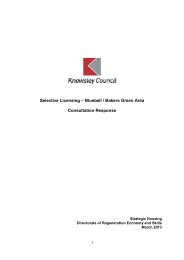Knowsley Replacement Unitary Development Plan - Knowsley Council
Knowsley Replacement Unitary Development Plan - Knowsley Council
Knowsley Replacement Unitary Development Plan - Knowsley Council
You also want an ePaper? Increase the reach of your titles
YUMPU automatically turns print PDFs into web optimized ePapers that Google loves.
TRANSPORT<br />
TRANSPORT<br />
POLICY T7:<br />
NEW DEVELOPMENT AND WALKING &<br />
CYCLING ROUTES<br />
1. New development should preserve and where<br />
possible enhance the walking & cycling<br />
network, as it can help enhance and provide<br />
access to green corridors & the countryside as<br />
well as promoting and encouraging exercise<br />
and healthy living for all.<br />
2. In considering proposals for new development<br />
which will block (either partially or wholly) an<br />
existing right of way or other existing or<br />
proposed walking or cycling route, a balanced<br />
consideration of the following factors will<br />
be undertaken:<br />
a) The contribution that the route makes or<br />
will make to the walking and/or cycling<br />
network in the area and the harm that<br />
would be caused to accessibility between<br />
existing uses in the surrounding area if the<br />
route were no longer available; and<br />
b) Any benefits to community safety or<br />
security that could arise from the closure<br />
of the route.<br />
3. In the event of it being minded to approve a<br />
development that would have an adverse<br />
effect on existing pedestrian or cycle<br />
networks, the <strong>Council</strong> will seek to secure<br />
alternative provision of equivalent quality,<br />
safety and convenience.<br />
EXPLANATION T7<br />
8.35<br />
There is a comprehensive network of rights of way<br />
within the Borough, which are designated as<br />
footpaths or bridleways on the definitive Rights of<br />
Way map. One route (the Trans-Pennine Trail) is part<br />
of a strategic long distance trail. Many footpaths and<br />
cycle routes, whilst not formally designated as rights<br />
of way, are also considered to provide important links<br />
(often within the built up area) as outlined in the<br />
Countryside Recreation Strategy for <strong>Knowsley</strong><br />
(approved 1996) which also includes a vision for the<br />
development of a “<strong>Knowsley</strong> Way” footpath and<br />
associated link footpaths. However these are still<br />
under development and as yet are insufficiently<br />
defined to show on the Proposals Map. There is also<br />
the potential in the future, where appropriate, for the<br />
<strong>Council</strong> to identify Quiet Lanes (see glossary) which<br />
are vehicular routes where traffic travels at slow<br />
enough speeds to make walking, cycling, or horse<br />
riding enjoyable. The <strong>Council</strong> will similarly<br />
consider the potential in the future to identify<br />
“Greenways” if appropriate, where walking and<br />
cycling will form part of informal recreational<br />
corridors. Footpaths and cycleways can have great<br />
benefits by helping promote and encourage<br />
exercise and healthy living for all as well as<br />
enhancing and providing access to green corridors<br />
and the countryside.<br />
8.36<br />
However, footpaths can sometimes contribute to the<br />
risk of crime and nuisance, particularly where they<br />
run at the back of buildings without adequate natural<br />
surveillance. In some cases it has been necessary for<br />
the <strong>Council</strong> to seek the closure of such routes in the<br />
interests of the amenity of neighbouring residents<br />
and of preventing unauthorised access to property.<br />
8.37<br />
In considering proposals affecting rights of way, the<br />
<strong>Council</strong> will take a balanced approach, which will<br />
weigh up the benefits of keeping the route open<br />
compared to any security or safety concerns that<br />
could arise from doing this. The more important the<br />
route is to accessibility in the area, the less likely<br />
permission is to be granted for any development,<br />
which would affect the route. Where a development<br />
would interfere with or block a footpath or cycle<br />
route, the <strong>Council</strong> will seek to agree alternative<br />
provision with the developer. It will be important to<br />
ensure that any alternative provision is itself safe,<br />
convenient and uses attractive boundary treatments,<br />
lighting and surface materials.<br />
POLICY LINKS<br />
Policy DQ1<br />
“Design Quality in New <strong>Development</strong>”<br />
Policy DQ2<br />
“Security in the Built Environment”<br />
POLICY T8:<br />
TRANSPORT ASSESSMENTS<br />
<strong>Development</strong> proposals that would prejudice the<br />
primary function of any part of the highway<br />
network (i.e. the motorway, trunk road, primary<br />
and local highway network) by generating a<br />
material increase in traffic, which would overload<br />
the access to, or any part of the network, will not<br />
be permitted, unless the necessary mitigation<br />
measures required are undertaken.<br />
<strong>Plan</strong>ning applications for the following forms of<br />
development will be required to be accompanied by<br />
a Transport Assessment:<br />
a) Major traffic generating development<br />
proposals as defined in table 8.1;<br />
b) Proposals which, either by themselves or in<br />
conjunction with wider proposals of which the<br />
development forms a part, are likely to cause<br />
significant harm as a result of existing road<br />
capacity or safety problems in the area;<br />
c) Proposals which are likely to significantly<br />
increase pollution and/or noise as a result of<br />
traffic generation; or cause pollution levels in<br />
Air Quality Management areas to exceed<br />
guideline levels;<br />
d) Proposals that would generate a material<br />
increase in traffic entering or using any<br />
motorways, trunk roads or other primary<br />
routes; and<br />
e) Proposals that would impact on the<br />
bus network.<br />
EXPLANATION T8<br />
8.38<br />
Large-scale developments can have significant<br />
transport implications. The submission of transport<br />
assessments with planning applications enables<br />
these implications to be fully assessed. The aim is to<br />
manage travel demand so as to limit the effects of<br />
traffic generation on the environment (e.g. through<br />
noise or air pollution), and to provide for safe and<br />
easy access for all users to the site by all modes of<br />
travel. Not all proposals will require a full Transport<br />
Assessment. However, the <strong>Council</strong> will seek to<br />
ensure that adequate information is submitted with<br />
each planning application to ensure that the<br />
implications of the development for the transport<br />
network are adequately assessed.<br />
8.39<br />
The Highways Agency has responsibility for the<br />
maintenance of the motorway, trunk roads and other<br />
primary routes on behalf of the Secretary of State.<br />
In regard to motorways, the Secretary of State has a<br />
strict policy of not allowing direct access to<br />
motorways other than for motorway service stations,<br />
or motorway maintenance compounds. The Agency if<br />
necessary can direct the <strong>Council</strong> to refuse planning<br />
applications for developments whose access<br />
arrangements breach this policy.<br />
8.40<br />
A Transport Assessment is required to identify<br />
whether or not a proposal is feasible in traffic terms,<br />
and to ascertain the necessity and scope for<br />
acceptable highway improvement works or other<br />
mitigation measures. Works may be required to<br />
protect the safety and efficiency of the trunk and local<br />
road networks. Any development must be<br />
satisfactorily integrated into and coordinated with the<br />
highway network.<br />
90<br />
KNOWSLEY REPLACEMENT UNITARY DEVELOPMENT PLAN: Adopted June 2006<br />
KNOWSLEY REPLACEMENT UNITARY DEVELOPMENT PLAN: Adopted June 2006<br />
91


